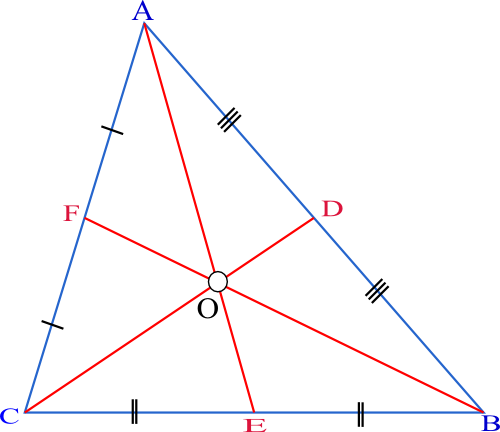
Find the lengths of the medians of the triangle with vertices A (0,0,6), B (0,4,0) and C (6, 0, 0).
Answer
606.6k+ views
Hint: For solving the problem, we should know about the basics of finding a median from each of the vertices of the triangle. Finally, we can find the length of the medians by using distance formula on the vertices joining two points of a median. Distance formula is given by \[\sqrt{{{({{x}_{1}}-{{x}_{2}})}^{2}}+{{({{y}_{1}}-{{y}_{2}})}^{2}}+{{({{z}_{1}}-{{z}_{2}})}^{2}}}\]. Here, $({{x}_{1}},{{y}_{1}},{{z}_{1}})\text{ }and\text{ }({{x}_{2}},{{y}_{2}},{{z}_{2}})$ are the respective vertices between which we want to find the distance.
Complete step-by-step answer:
Basically, before starting to solve the problem, we first try to understand the definition of median which would be useful for doing this question. A median of a triangle is a line segment joining a vertex to the midpoint of the opposite side, thus bisecting that side. Thus, in the below figure of triangle, AE, CD, and BF are the three medians of the triangle. We first start by plotting the vertices A, B and C and then finding the respective mid-points of the sides AB, BC and CA.

Here, E, D and F are the respective mid-points of CB, AB and AC. Let A (0,0,6), B (0,4,0) and C (6,0,0).
Now, to find the midpoint between $({{x}_{1}},{{y}_{1}},{{z}_{1}})\text{ }and\text{ }({{x}_{2}},{{y}_{2}},{{z}_{2}})$, the formula is \[\left( \dfrac{{{x}_{1}}+{{x}_{2}}}{2},\dfrac{{{y}_{1}}+{{y}_{2}}}{2},\dfrac{{{z}_{1}}+{{z}_{2}}}{2}\text{ } \right)\] for $({{x}_{1}},{{y}_{1}},{{z}_{1}})\text{ }and\text{ }({{x}_{2}},{{y}_{2}},{{z}_{2}})$ to be the respective vertices of the side of a triangle. Thus, we use this to find E, D and F. Thus, we get,
E = \[\left( \dfrac{{{x}_{1}}+{{x}_{2}}}{2},\dfrac{{{y}_{1}}+{{y}_{2}}}{2},\dfrac{{{z}_{1}}+{{z}_{2}}}{2}\text{ } \right)=\left( \dfrac{0+6}{2},\dfrac{4+0}{2},\dfrac{0+0}{2} \right)\]= (3,2,0)
D=\[\left( \dfrac{{{x}_{1}}+{{x}_{2}}}{2},\dfrac{{{y}_{1}}+{{y}_{2}}}{2},\dfrac{{{z}_{1}}+{{z}_{2}}}{2}\text{ } \right)=\left( \dfrac{0+0}{2},\dfrac{0+4}{2},\dfrac{6+0}{2} \right)\]= (0,2,3)
F=\[\left( \dfrac{{{x}_{1}}+{{x}_{2}}}{2},\dfrac{{{y}_{1}}+{{y}_{2}}}{2},\dfrac{{{z}_{1}}+{{z}_{2}}}{2}\text{ } \right)=\left( \dfrac{0+6}{2},\dfrac{0+0}{2},\dfrac{6+0}{2} \right)\]= (3,0,3)
Now, we try to find median lengths using the distance formula. We have distance formula as \[\sqrt{{{({{x}_{1}}-{{x}_{2}})}^{2}}+{{({{y}_{1}}-{{y}_{2}})}^{2}}+{{({{z}_{1}}-{{z}_{2}})}^{2}}}\]. Thus,
AD = \[\sqrt{{{({{x}_{1}}-{{x}_{2}})}^{2}}+{{({{y}_{1}}-{{y}_{2}})}^{2}}+{{({{z}_{1}}-{{z}_{2}})}^{2}}}=\sqrt{{{(3-0)}^{2}}+{{(2-0)}^{2}}+{{(0-6)}^{2}}}=\sqrt{49}\]= 7
BE =\[\sqrt{{{({{x}_{1}}-{{x}_{2}})}^{2}}+{{({{y}_{1}}-{{y}_{2}})}^{2}}+{{({{z}_{1}}-{{z}_{2}})}^{2}}}=\sqrt{{{(3-0)}^{2}}+{{(0-4)}^{2}}+{{(3-0)}^{2}}}=\sqrt{34}\]
CF = \[\sqrt{{{({{x}_{1}}-{{x}_{2}})}^{2}}+{{({{y}_{1}}-{{y}_{2}})}^{2}}+{{({{z}_{1}}-{{z}_{2}})}^{2}}}=\sqrt{{{(0-6)}^{2}}+{{(2-0)}^{2}}+{{(3-0)}^{2}}}=\sqrt{49}\]= 7
Hence, the length of the medians are 7, $\sqrt{34}$ and 7.
Note: Another alternative to finding the lengths of the median of the triangle is to use the formula by Apollonius’ theorem –
$\sqrt{\dfrac{2{{b}^{2}}+2{{c}^{2}}-{{a}^{2}}}{4}}$, $\sqrt{\dfrac{2{{a}^{2}}+2{{c}^{2}}-{{b}^{2}}}{4}}$, $\sqrt{\dfrac{2{{a}^{2}}+2{{b}^{2}}-{{c}^{2}}}{4}}$. Here; a, b and c are the lengths of the sides of the triangle opposite to angles A, B and C.
Complete step-by-step answer:
Basically, before starting to solve the problem, we first try to understand the definition of median which would be useful for doing this question. A median of a triangle is a line segment joining a vertex to the midpoint of the opposite side, thus bisecting that side. Thus, in the below figure of triangle, AE, CD, and BF are the three medians of the triangle. We first start by plotting the vertices A, B and C and then finding the respective mid-points of the sides AB, BC and CA.

Here, E, D and F are the respective mid-points of CB, AB and AC. Let A (0,0,6), B (0,4,0) and C (6,0,0).
Now, to find the midpoint between $({{x}_{1}},{{y}_{1}},{{z}_{1}})\text{ }and\text{ }({{x}_{2}},{{y}_{2}},{{z}_{2}})$, the formula is \[\left( \dfrac{{{x}_{1}}+{{x}_{2}}}{2},\dfrac{{{y}_{1}}+{{y}_{2}}}{2},\dfrac{{{z}_{1}}+{{z}_{2}}}{2}\text{ } \right)\] for $({{x}_{1}},{{y}_{1}},{{z}_{1}})\text{ }and\text{ }({{x}_{2}},{{y}_{2}},{{z}_{2}})$ to be the respective vertices of the side of a triangle. Thus, we use this to find E, D and F. Thus, we get,
E = \[\left( \dfrac{{{x}_{1}}+{{x}_{2}}}{2},\dfrac{{{y}_{1}}+{{y}_{2}}}{2},\dfrac{{{z}_{1}}+{{z}_{2}}}{2}\text{ } \right)=\left( \dfrac{0+6}{2},\dfrac{4+0}{2},\dfrac{0+0}{2} \right)\]= (3,2,0)
D=\[\left( \dfrac{{{x}_{1}}+{{x}_{2}}}{2},\dfrac{{{y}_{1}}+{{y}_{2}}}{2},\dfrac{{{z}_{1}}+{{z}_{2}}}{2}\text{ } \right)=\left( \dfrac{0+0}{2},\dfrac{0+4}{2},\dfrac{6+0}{2} \right)\]= (0,2,3)
F=\[\left( \dfrac{{{x}_{1}}+{{x}_{2}}}{2},\dfrac{{{y}_{1}}+{{y}_{2}}}{2},\dfrac{{{z}_{1}}+{{z}_{2}}}{2}\text{ } \right)=\left( \dfrac{0+6}{2},\dfrac{0+0}{2},\dfrac{6+0}{2} \right)\]= (3,0,3)
Now, we try to find median lengths using the distance formula. We have distance formula as \[\sqrt{{{({{x}_{1}}-{{x}_{2}})}^{2}}+{{({{y}_{1}}-{{y}_{2}})}^{2}}+{{({{z}_{1}}-{{z}_{2}})}^{2}}}\]. Thus,
AD = \[\sqrt{{{({{x}_{1}}-{{x}_{2}})}^{2}}+{{({{y}_{1}}-{{y}_{2}})}^{2}}+{{({{z}_{1}}-{{z}_{2}})}^{2}}}=\sqrt{{{(3-0)}^{2}}+{{(2-0)}^{2}}+{{(0-6)}^{2}}}=\sqrt{49}\]= 7
BE =\[\sqrt{{{({{x}_{1}}-{{x}_{2}})}^{2}}+{{({{y}_{1}}-{{y}_{2}})}^{2}}+{{({{z}_{1}}-{{z}_{2}})}^{2}}}=\sqrt{{{(3-0)}^{2}}+{{(0-4)}^{2}}+{{(3-0)}^{2}}}=\sqrt{34}\]
CF = \[\sqrt{{{({{x}_{1}}-{{x}_{2}})}^{2}}+{{({{y}_{1}}-{{y}_{2}})}^{2}}+{{({{z}_{1}}-{{z}_{2}})}^{2}}}=\sqrt{{{(0-6)}^{2}}+{{(2-0)}^{2}}+{{(3-0)}^{2}}}=\sqrt{49}\]= 7
Hence, the length of the medians are 7, $\sqrt{34}$ and 7.
Note: Another alternative to finding the lengths of the median of the triangle is to use the formula by Apollonius’ theorem –
$\sqrt{\dfrac{2{{b}^{2}}+2{{c}^{2}}-{{a}^{2}}}{4}}$, $\sqrt{\dfrac{2{{a}^{2}}+2{{c}^{2}}-{{b}^{2}}}{4}}$, $\sqrt{\dfrac{2{{a}^{2}}+2{{b}^{2}}-{{c}^{2}}}{4}}$. Here; a, b and c are the lengths of the sides of the triangle opposite to angles A, B and C.
Recently Updated Pages
Master Class 10 General Knowledge: Engaging Questions & Answers for Success

Master Class 10 Computer Science: Engaging Questions & Answers for Success

Master Class 10 English: Engaging Questions & Answers for Success

Master Class 10 Social Science: Engaging Questions & Answers for Success

Master Class 10 Maths: Engaging Questions & Answers for Success

Master Class 10 Science: Engaging Questions & Answers for Success

Trending doubts
The shortest day of the year in India

Why is there a time difference of about 5 hours between class 10 social science CBSE

Write a letter to the principal requesting him to grant class 10 english CBSE

What is the median of the first 10 natural numbers class 10 maths CBSE

The Equation xxx + 2 is Satisfied when x is Equal to Class 10 Maths

State and prove converse of BPT Basic Proportionality class 10 maths CBSE




